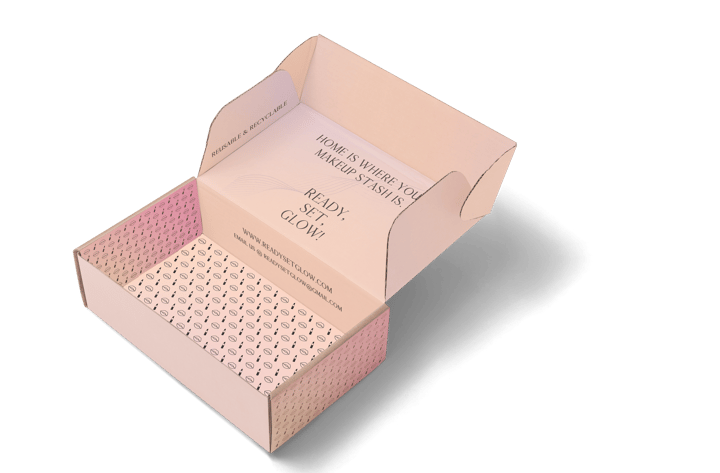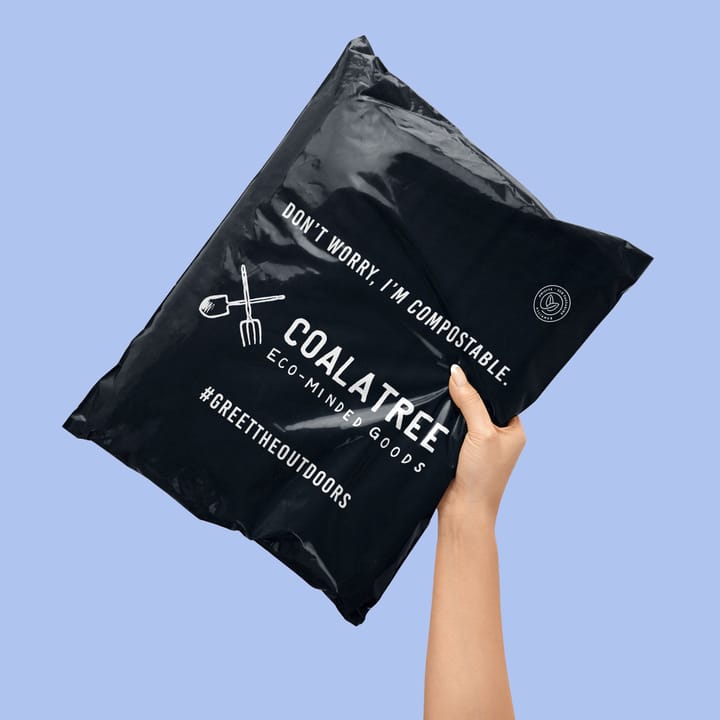
The Ultimate Guide to Compostable Packaging Materials
Ready to use compostable packaging? Here's everything you need to know about compostable materials and how to teach your customers about end-of-life care.
By Elly Strang — 15 March, 2022
Not sure which type of mailer is best for your brand? Here's what your business should know about choosing between noissue Recycled, Kraft, and Compostable Mailers.
Compostable packaging is a type of packaging material that follows the principles of the circular economy.
Instead of the traditional ‘take-make-waste’ linear model used in commerce, compostable packaging is designed to be disposed of in a responsible way that has a lower impact on the planet.
While compostable packaging is a material many businesses and consumers are familiar with, there still some misunderstandings about this eco-friendly packaging alternative.
Are you thinking about using compostable packaging in your business? It pays to know as much as possible about this type of material so you can communicate with and educate customers on the right ways to dispose of it after use. In this guide, you'll learn:
- What bioplastics are
- What packaging products can be composted
- How paper and cardboard can be composted
- The difference between biodegradable vs. compostable
- How to talk about composting materials with confidence.
Let's get into it!
What is compostable packaging?

Compostable packaging is packaging that will break down naturally when left in the right environment. Unlike traditional plastic packaging, it is made from organic materials that break down in a reasonable period of time and leave no toxic chemicals or harmful particles behind. Compostable packaging can be made from three types of materials: paper, cardboard or bioplastics.
Learn more about other types of circular packaging materials (recycled and reusable) here.
What are bioplastics?
Bioplastics are plastics that are bio-based (made from a renewable resource, like vegetables), biodegradable (able to break down naturally) or a combination of both. Bioplastics help to reduce our reliance on fossil fuels for plastic production and can be made from corn, soybeans, wood, used cooking oil, algae, sugarcane and more. One of the most commonly used bioplastics in packaging is PLA.
What is PLA?
PLA stands for polylactic acid. PLA is a compostable thermoplastic derived from plant extracts like cornstarch or sugarcane and is carbon-neutral, edible and biodegradable. It’s a more natural alternative to fossil fuels, but it’s also a virgin (new) material that has to be extracted from the environment. PLA disintegrates completely when it breaks down rather than crumbling into harmful micro-plastics.
PLA is made by growing a crop of plants, like corn, and then is broken down into starch, protein and fiber to create PLA. While this is a much less harmful extraction process than traditional plastic, which is created through fossil fuels, this is still resource-intensive and one criticism of PLA is it takes away land and plants that are used to feed people.
Pros and cons of compostable packaging

Considering using compostable packaging? There are both advantages and drawbacks of using this type of material, so it pays to weigh up the pros and cons for your business.
Pros
Compostable packaging has a smaller carbon footprint than traditional plastic. The bioplastics used in compostable packaging produce significantly fewer greenhouse gasses over their lifetime than traditional fossil-fuel produced plastics. PLA as a bioplastic takes 65% less energy to produce than traditional plastic and generates 68% fewer greenhouse gasses.
Bioplastics and other types of compostable packaging break down extremely fast when compared to traditional plastic, which can take more than 1000 years to decompose. noissue’s Compostable Mailers are TUV Austria certified to break down within 90 days in a commercial compost and 180 days in a home compost.
In terms of circularity, compostable packaging breaks down into nutrient-rich materials that can be used as a fertilizer around the home to improve soil health and strengthen environmental ecosystems.
Cons
Compostable plastic packaging needs the right conditions in a home or commercial compost in order to be able to decay and complete its end-of-life cycle. Disposing of it in the incorrect way can have harmful consequences as if a customer puts it in their normal rubbish or recycling, it will end up in a landfill and may release methane. This greenhouse gas is 23 times more potent than carbon dioxide.
Composting packaging requires more knowledge and effort on the customer’s end to successfully dispose of it. Easily accessible composting facilities aren’t as widespread as recycling facilities, so this may pose a challenge for someone who doesn’t know how to compost. Education being passed on from businesses to their customer base is key.
It is also important to note that compostable packaging is made of organic materials, which means it has a shelf life of 9 months if stored correctly in a cool, dry place. It must be kept out of direct sunlight and away from humid conditions in order to be intact and preserved for this amount of time.
Why is traditional plastic packaging bad for the environment?
Traditional plastic packaging comes from a non-renewable resource: petroleum. To source this fossil fuel and break it down after use isn't an easy process for our environment.
Extracting petroleum from our planet creates a large carbon footprint and once the plastic packaging is discarded, it contaminates the environment around it by breaking down into micro-plastics. It is also non-biodegradable, as it can take more than 1000 years to decompose in a landfill.
⚠️ Plastic packaging is the main contributor to plastic waste in our landfills and is responsible for almost half of the global total.
Can paper and cardboard be composted?

Paper is safe to use in a compost because it is a fully natural and renewable resource created from trees and can be broken down over time. The only time you might encounter a problem composting paper is when it is colored with certain dyes or has a glossy coating, as this can release toxic chemicals during the decaying process. Packaging like noissue’s Compostable Tissue Paper is home compost-safe because the paper is Forest Stewardship Council certified, lignin and sulfur-free and uses soy-based inks, which are eco-friendly and don’t release chemicals as they break down.
Cardboard is compostable because it’s a source of carbon and helps with a compost’s carbon-nitrogen ratio. This provides the microorganisms in a compost heap with the nutrients and energy they need to turn these materials into compost. noissue’s Kraft Boxes and Kraft Mailers are great additions to your compost heap. Cardboard should be mulched (shredded and soaked with water) and then it will break down reasonably quickly. On average, it should take about 3 months.
noissue packaging products that can be composted

noissue has a wide range of packaging products that be composted. Here, we'll break it down by material type.
Paper
Custom Tissue Paper. Our tissue uses FSC-certified, acid and lignin-free paper that's printed using soy-based inks.
Custom Foodsafe Paper. Our foodsafe paper is printed on FSC-certified paper with water-based foodsafe inks.
Custom Stickers. Our stickers use FSC-certified, acid-free paper and are printed using soy-based inks.
Stock Kraft Tape. Our tape is made using recycled Kraft paper.
Custom Washi Tape. Our tape is made from rice paper using a non-toxic adhesive and printed with non-toxic inks.
Stock Shipping Labels. Our shipping labels are made from FSC-certified recycled paper.
Custom Kraft Mailers. Our mailers are made from 100% FSC-certified recycled Kraft paper and printed with water-based inks.
Stock Kraft Mailers. Our mailers are made from 100% FSC-certified recycled Kraft paper.
Custom Printed Cards. Our cards are made from FSC-certified paper and printed with soy-based inks.
Bioplastic
Compostable Mailers. Our mailers are TUV Austria certified and made from PLA and PBAT, a bio-based polymer. They are certified to break down within six months at home and three months in a commercial environment.
Cardboard
Custom Shipping Boxes. Our boxes are made from recycled Kraft E-flute board and printed with HP indigo compostable inks.
Stock Shipping Boxes. Our boxes are made from 100% recycled Kraft E-flute board.
Custom Hang Tags. Our hang tags are made from FSC-certified recycled card stock and printed with soy or HP non-toxic inks.
How to educate customers about composting

Your customers have two options for composting their packaging at its end-of-life: they can find a composting facility near their home (this could be an industrial or community facility) or they can compost packaging themselves at home.
How to find a composting facility
North America: Find a commercial facility with Find a Composter.
United Kingdom: Find a commercial facility on Veolia or Envar's websites, or check out the Recycle Now site for local collection options.
Australia: Find a collection service through the Australia Industry Association for Organics Recycling website or donate to someone else's home compost through ShareWaste.
Europe: Varies by country. Visit local goverment websites for more information.
How to compost at home
To help people on their home composting journey, we've created two guides:
If you need help educating your customers on how to compost at home, these articles are full of tips and tricks. We'd recommend sending the article along to your customers, or repurposing some of the information for your own communications!
Wrapping it up
We hope this guide has helped shed some light on this wonderful sustainable packaging material! Compostable packaging has pros and cons, but overall, this material is one of the most environmentally friendly solutions we’ve got in the fight against plastic packaging.
Interested in learning more about other types of circular packaging materials? Check out these guides on our Reusable and Recycle frameworks and products. Now's the perfect time to replace plastic packaging with a more sustainable alternative! Read this article to learn about PLA and bioplastic packaging.
Ready to get started with compostable packaging materials and minimize your packaging waste? 🌱 Browse our composting packaging options by industry here!